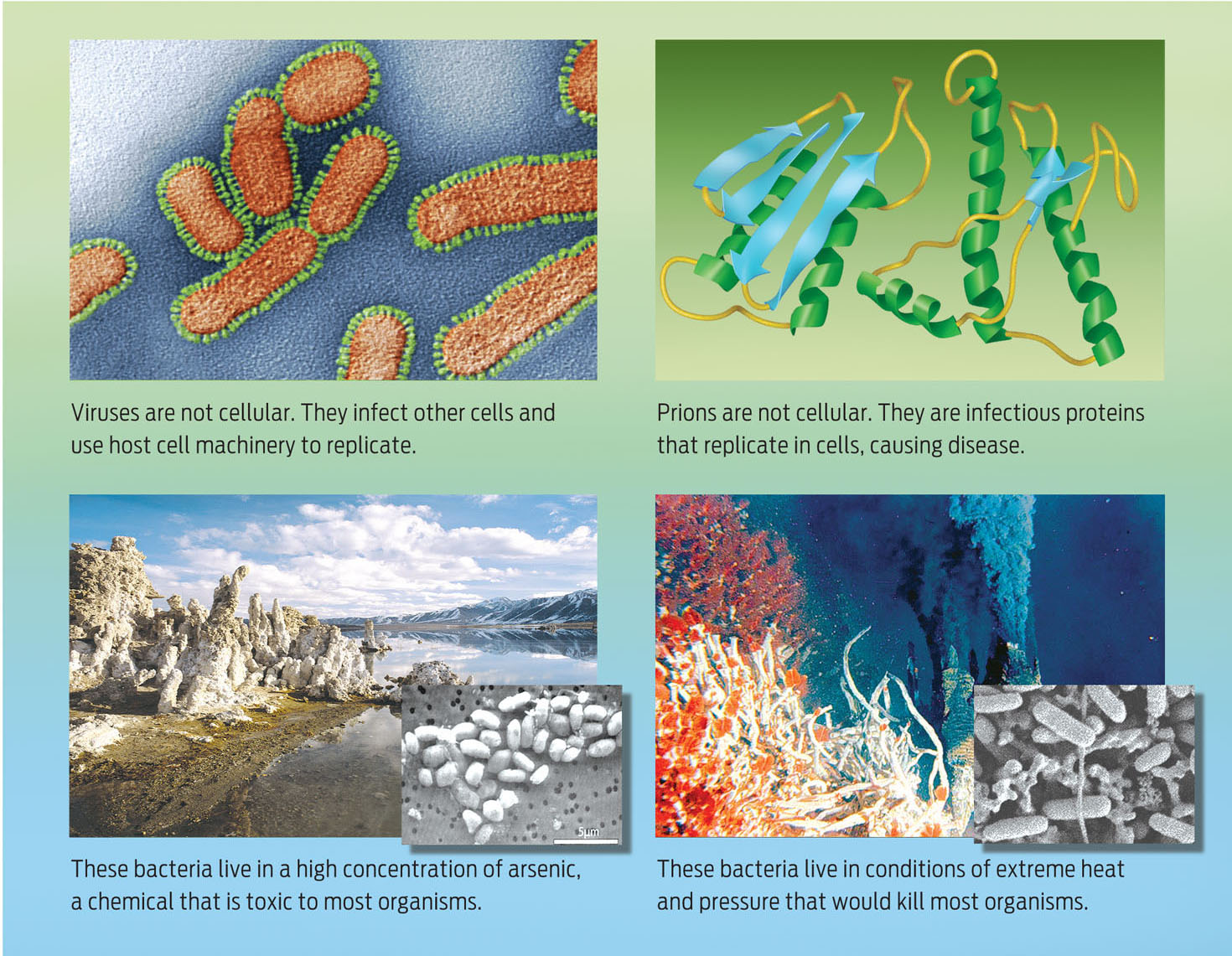“WIERD LIFE”
VIRUS An infectious agent made up of a protein shell that encloses genetic information.
PRION A protein-only infectious agent.
So far, NASA’s search for life on Mars has stuck very closely to our understanding of life on Earth, where living things seem to share certain chemical and structural properties, like carbon-based molecules and cells. Nevertheless, there are a few exceptions, or boundary cases, that seem to bend the rules of life on Earth. Viruses, for example, reproduce and pass their genetic information on to new viruses, but they are not made of cells. Instead, they consist of a protein shell that encloses genetic information. Viruses reproduce by infecting a host cell and hijacking its cellular machinery to make copies of itself. Other noncellular, self-reproducing entities include prions infectious proteins that are responsible for mad cow disease and related illnesses. Whether or not viruses and prions are truly alive is hotly debated among scientists (INFOGRAPHIC 2.10) .
Many organisms defy our criteria for living organisms, and many infectious agents that are not technically alive have powerful impacts on living organisms.

If viruses and prions bend the rules, then might not Martian life as well? In 2007, the National Academy of Sciences issued a “weird life” report suggesting that NASA should not be so narrowly focused on water and organic molecules in its search for life on other planets. True, water may be crucial to life on Earth, but that doesn’t mean that other solvents–ammonia or methane, for example–could not support life elsewhere, the report noted. The report also urged the space agency to avoid being “fixated on carbon,” even though carbon forms the scaffold of life on Earth. Other elements, for example silicon, could hypothetically provide a functional scaffold for life on other planets.
39
We shouldn’t lock ourselves into a definition that might blind us to the presence of unfamiliar forms of life should we be so fortunate to encounter them.
— CAROL CLELAND
“Because our experience of life is limited to a single example–familiar Earth life,” says philosopher Cleland, “we shouldn’t lock ourselves into a definition that might blind us to the presence of unfamiliar forms of life should we be so fortunate to encounter them.”
In 2010, researchers with the U. S. Geological Survey reported a very unusual finding that seemed to bear out this warning: they had discovered a bacterium, in a lake full of arsenic, that apparently could substitute arsenic for phosphorus in its DNA. In other words, this bacterium was an apparent exception to the “universal” formula of life. And not only that, it broke the rules by incorporating an element–arsenic–that is wickedly poisonous to most living creatures on Earth. The news made a big splash when it was first reported.
Unfortunately, other researchers were not able to reproduce the controversial findings, and scientists now think that this “exception” does not hold up: the bacteria do need phosphorus, and the universal formula of life stands unbroken.
Nevertheless, the fact that this bug can live happily in a lake full of poison does challenge our notions of what life looks like and where it can survive. Microscopic organisms have been found living just about anywhere on Earth, from radioactive waste and deep-sea vents to frozen Antarctic lakes submerged under miles of ice. Such extreme-loving organisms reveal that life is nothing if not adaptive. Could similarly adaptive organisms have once inhabited Mars? Might they still? NASA researchers are cautiously optimistic.
In December 2012, Curiosity ran its first sample of Martian dirt through SAM. No definitive proof of organics yet, but the rover still has many more promising locations to search within Gale Crater. Will Curiosity find what she is looking for? McKay, for one, is confident she will.
“I spend my time and energy in the search for evidence of life on Mars,” he says. “Obviously, this is because I think there must have been life there and we have a good chance of finding evidence of it.” 
40